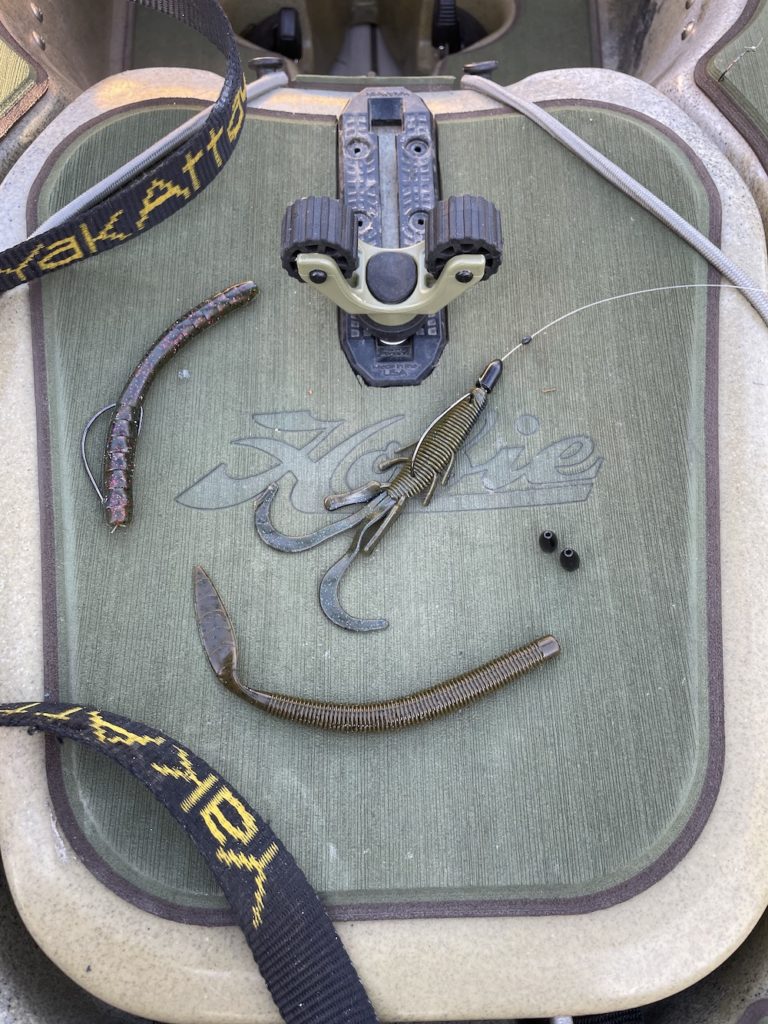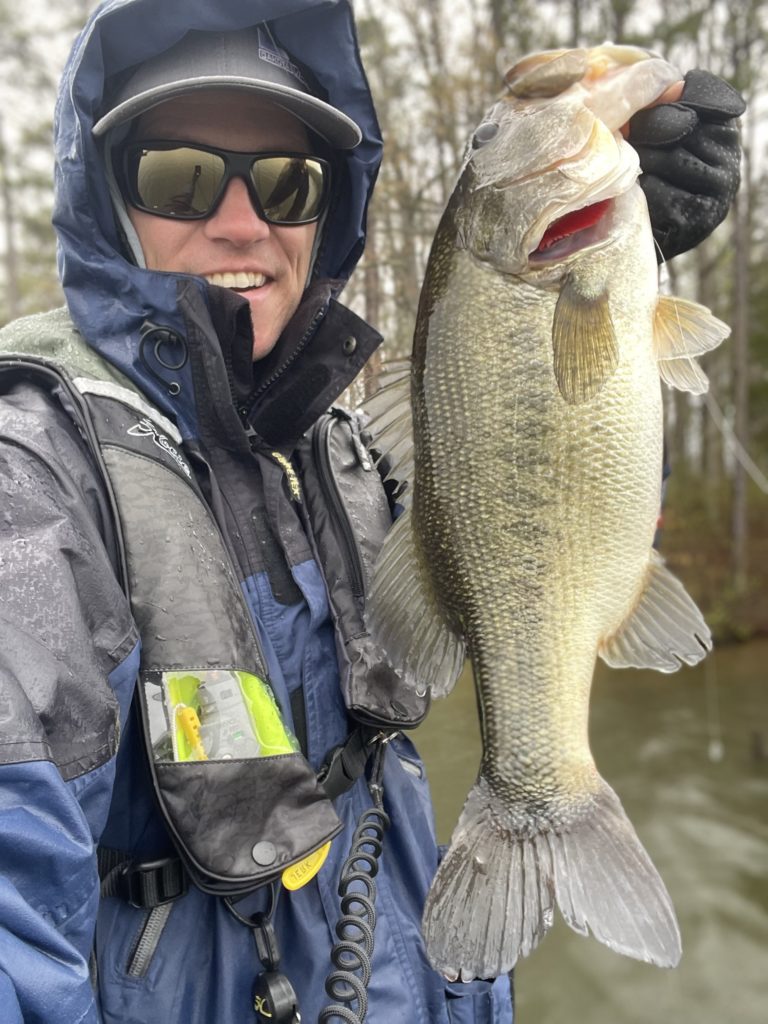April is my favorite month of the year. The weather is beautiful, the fishing is excellent across the Southeast, and it’s time for the bass spawn here in Virginia. The exact time that the females move to the bank varies slightly from year to year. Factors like length of day and moon phase don’t change year to year, but weather can impact water temperatures enough to accelerate or delay the spawn, especially on smaller bodies of water. I remember a year where a string of near 90-degree days in March caused an unusually early spawn on a small lake in Northern Virginia. Typically though, April is when most Virginia bass will spawn. During this window they’ll be shallow and accessible. You won’t need a shiny bass boat, fancy electronics or a giant tacklebox to trick them. With just a handful of tools, anyone has the potential to encounter and land the fish of a lifetime.
Bed fishing is one of my favorite things to do. I’ve got lots of info to share, so I’ll break it into two parts. Part 1 will cover some background information, along with the tools you’ll need. I’ll delve into the art of catching them in Part 2. Here we go.
Catching bedding bass isn’t for everyone. Some consider it unethical, and others just don’t like it. I’m not in either camp. So long as anglers aren’t intentionally snagging fish and they abide by all state regulations, I say go for it. There’s nothing like the challenge of singular combat with a giant fish that you can see. At the same time, it can be frustrating when you find that trophy fish but can’t trick her into biting. Sight fishing can also burn you in tournament. Big females are notorious for being here today and gone tomorrow. Nevertheless, it’s such a fun bite that I look for it every spring, as soon as the water warms to 60 degrees.
Probably the most important tool for sight fishing is a pair of polarized sunglasses. They cut out glare and allow you to see further below the surface. This allows you to spot fish that can’t see with the naked eye. They also protect your eyes from UV rays and flying lures. My first pair of glasses was the cheapest one I could find at Walmart. They worked okay, but the lens quality wasn’t great. I used to get headaches, which I suspect was partly from the lenses and partly because I wasn’t hydrating properly in those days. Years later, when I upgraded to a pair of expensive Oakleys, the headaches went away. Last fall I was introduced to Hobie Eyewear. I bought a second pair in January, and they’ve become my go-to. The Mojo model I use floats – a must if you fish from a kayak. It also costs half what the Oakleys and most high-end brands cost. I keep two pairs in my Blackpak, a sightmaster lens for low light and a grey lens for bright, sunny days. Believe me, it makes a difference in your ability to see. The second pair also serves as a backup, which is nice if you’re accident prone. I had a cheap pair break during a BFL event years ago, and I fished the whole day with one lens, looking like a pirate. Not fun.

When it comes to fishing for giant bedding fish, soft plastics are king. My biggest sight fish – 9-lb giant – came several years back on a 6” lizard. That old school lure may have accounted for more bedding fish than any bait ever made. They’re inexpensive, a bunch of companies make them, and you can find them anywhere that sells fishing tackle. Something about the lizard’s profile really agitates those fish. In recent years, the Missile Baits Baby D Stroyer has replaced my lizards. It’s got a similar look and action. Texas-rigged, with a 3/16 oz sinker, it’s often my first choice. My second pick is a straight-tailed worm, the Missile Baits Quiver 6.5, with a light weight. I’ll usually start with a 1/8 oz and go up or down based on how the fish react. My third choice would be a weightless stickworm, the Missile 48. If the fish are extremely finicky and I’m using light line, I’ll rig it wacky style. Around grass or other thick cover, I’ll go up in line size and rig Texas style. Those three baits will catch bedding fish anywhere in the country.
My setups are pretty simple for bed fishing. I’ll use spinning gear for the weightless 48. A 7-ft medium action rod is perfect. In clear water without a lot of cover to snag, I’ll use 15-20 lb Vicious Braid with an 8 lb leader of Vicious Fluorocarbon or Vicious Pro Elite. Around heavier cover, I’ll beef up to a 12 lb leader. I’ll occasionally throw straight braid, but only around the thickest cover and if the fish aren’t picky. I have two baitcast setups. The lighter is a 7-ft, medium-heavy, Quantum Smoke Rod, which I’ll use with smaller baits and lighter weights. It’s paired with a 7.1 or 8.1 Smoke reel that’s spooled with 14-17 lb Vicious Fluorocarbon. I get better sensitivity with the 14, but the extra strength of 17 is nice to have if I’m around big fish and heavy cover. 17 gets the nods in Florida, for example. My heavier setup is a 7’4” heavy action Smoke baitcaster with the same Smoke reel. I’m spooling 17-25 lb fluorocarbon on this one, and I use it to throw heavier weights and bigger baits. If I’m fishing something like a full-sized D Bomb or D Stroyer around wood, the beefy setup gives me a better chance of getting the fish out.
So you’ve got your polarized glasses and a few packs of plastics, now what? Locating bedding fish is half the battle. I start to look for them in protected pockets on the northern side of the lake. These banks heat up first, and they’re protected from North wind. Bass spawn on hard bottom and they typically build nests next to whatever cover is available, including stumps, laydowns, dock posts, rockpiles, overhanging limbs, and grass. I’m usually looking for bedding fish on flats or gently sloping banks. Shallow grass flats can hold large numbers of spawning fish. Bass will use eelgrass, milfoil, coontail, water willow, arrowhead, and even pad stems when hard bottom isn’t available. They’re going to use the best habitat available to them. On highland reservoirs, I’ve seen fish spawn on ledges sticking out of steep bluff banks. The bed itself will typically look like a crater, 2 feet or so in diameter. Sometimes they stick out like a sore thumb. For example, if the bottom is covered in dark debris, the nest will be a bright spot where the male has fanned away debris. On a clean sand or gravel bottom, they can be more difficult to spot.
When I’m looking for bedding fish, I’m almost always paddling my Hobie from a standing position. Trolling motors controlled with a remote can be great for standing and looking too. Just make sure you’re quiet and you aren’t kicking up mud. For either option, you’ll need a stable kayak, designed for standing. Good balance is also a plus. Please don’t try to stand in a sit-in kayak or other craft not designed for it. It won’t end well. And don’t worry if you aren’t able to stand. With a quiet approach, it’s possible to sneak up on fish and spot them from a seated position. Typically, I’m moving slowly while searching for bedding fish, but I adjust based on conditions. Shallow, clear water and no wind are optimal. This allows me to see further, so I can go faster without missing anything. As the water gets deeper or dingier, or wind ripples the surface, it’s harder to spot beds and fish movement, so I slow down. Sunlight matters too, as does the time of day. You can spot fish on overcast or even rainy days, but it’s tough. The middle of a sunny day, from 11:00 AM to 2:00 PM, is prime time. With the sun directly overhead, you have the greatest field of vision, your shadow is minimal, and glare is less of a hindrance. This means that you can travel in any direction and be effective. Outside that window, when the sun is at a lower angle, your shadow can cause problems. With the sun at your back, this shadow will spook fish long before you’re close enough to see them. Moving into the sun solves the shadow problem but makes the glare terrible, limiting how far you can see. One solution for those times is to look for banks with long shade lines. In the shade, you can keep the sun at your back, and your shadow will be masked.
When you find a bed with a single fish on it, most likely it’s the male. Building the nest is their job. They fan out the circular next, using their tail to clear debris. Then they defend it from possible predators, even before a female arrives and deposits eggs. The male owns that bed from the time he builds it until the eggs hatch into fry. After the eggs hatch, the male no longer cares about the bed. He’s focused slowly on defending the fry, swimming circles around the fry ball as it moves slowly around the shallows. These fry guarders often swim erratically, chasing away bluegill and other small fish that get too close. If you see that behavior near a nest, don’t be fooled. It’s likely that the fish is guarding fry rather than the next. During the spawning cycle, the female is only present on a bed for a short time, from a few hours to a few days. She moves on soon after dropping her eggs, leaving the male with the job of defending. That means we have a short window to target those giant females.
Males are typically easier to catch because they’re already in a defensive mood. Your lizard or other soft plastic lure looks like an invader. The male sees it as a threat and wants to chase it away or kill it, regardless of whether a female is present. Females will also behave defensively, but it’s often only after they’ve deposited eggs. If you’ve ever heard people talk about a female “locking onto” a nest, it just means one that isn’t leaving. Sometimes you’ll see a female near a nest but just hovering around the perimeter. The male will be swimming out and trying to coax her onto the nest. Once she moves up and stays put, you have the best shot at catching her.
Ok, that’s a good stopping point. Stay tuned for Part 2, where I’ll discuss the fun part, tricking these fish. I’ll also share my thoughts on targeting spawning fish as a tournament strategy. Spoiler, it can work, but it’s risky.

